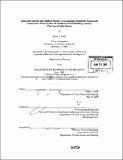| dc.contributor.advisor | Eran Ben-Joseph. | en_US |
| dc.contributor.author | Pauly, Justin T. (Justin Talbott) | en_US |
| dc.contributor.other | Massachusetts Institute of Technology. Dept. of Urban Studies and Planning. | en_US |
| dc.date.accessioned | 2006-07-13T15:11:40Z | |
| dc.date.available | 2006-07-13T15:11:40Z | |
| dc.date.copyright | 2005 | en_US |
| dc.date.issued | 2005 | en_US |
| dc.identifier.uri | http://hdl.handle.net/1721.1/33276 | |
| dc.description | Thesis (M.C.P.)--Massachusetts Institute of Technology, Dept. of Urban Studies and Planning, 2005. | en_US |
| dc.description | Includes bibliographical references (p. 154-150). | en_US |
| dc.description.abstract | The homebuilding industry has held a dominant presence in the U.S. economy over the past century. It has been a source of profit, shelter and jobs for countless Americans. In order to meet the needs of an ever-burgeoning population, the industry itself has grown into a complex and vast linkage of developers, designers, contractors and regulatory officials whose job it is to build the houses that most Americans live in. Yet the growth and success of the homebuilding industry in America has not come without repercussions. Today, more than ever, we are cognizant of the environmental impacts that the homebuilding industry is having on our physical landscape and our natural resources. As a response to this cognizance, there has been a growing movement towards less environmentally harmful methods of design and construction. Many, if not most, of these methods require substantial changes to the way the industry currently builds homes. In this sense, they are considered innovations. This thesis will provide an illustration of the process of innovation and how it diffuses throughout an existing industry in addition to recapping historical arguments for why the U.S. homebuilding industry has long been characterized as resistant to change. The industry, however, is currently witnessing several trends which begin to refute the notion that homebuilding is change-resistant. These trends and the effects that they are having on large scale production homebuilders, what I will refer to as mega-production builders, are leading to a period in which this ever-growing segment of the industry will be ripe for more innovative practices. To test this hypothesis, I have undertaken a case study of two divisions of America's second largest homebuilder, Pulte Homes. | en_US |
| dc.description.abstract | (cont.) The Las Vegas Division, through their partnership with the Department of Energy's Building America Program, is building more energy efficient homes largely through incremental product and process-based technologies. The Washington D.C. Division is pursuing more radical and systemic innovations through component manufacturing processes entirely independent of any government or third-party partnerships. 'This thesis finds that while both divisions have been largely successful to date, the potential for growth lies in the more systemic innovations being pursued in the Washington D.C. Division of -Pulte because these innovations are more strongly tied to Pulte's national agenda for expansion and can be improved upon more easily than the more incremental innovations pursued by Las Vegas. Furthermore, this thesis finds that the disconnect between design and engineering currently exhibited by most large production builders is a detriment to the adoption of more innovative practices and, finally, that government programs designed to foster innovation in homebuilding should focus more on small regional builders, corporate decision makers and product manufacturers as opposed to the independent operating divisions of large production builders. | en_US |
| dc.description.statementofresponsibility | by Justin T. Pauly. | en_US |
| dc.format.extent | 176 p. | en_US |
| dc.format.extent | 12321423 bytes | |
| dc.format.extent | 12331972 bytes | |
| dc.format.mimetype | application/pdf | |
| dc.format.mimetype | application/pdf | |
| dc.language.iso | eng | en_US |
| dc.publisher | Massachusetts Institute of Technology | en_US |
| dc.rights | M.I.T. theses are protected by copyright. They may be viewed from this source for any purpose, but reproduction or distribution in any format is prohibited without written permission. See provided URL for inquiries about permission. | en_US |
| dc.rights.uri | http://dspace.mit.edu/handle/1721.1/7582 | |
| dc.subject | Urban Studies and Planning. | en_US |
| dc.title | Innovation and the big builders : barriers to integrating sustainable design and construction practices into the production homebuilding industry : the case of Pulte Homes | en_US |
| dc.type | Thesis | en_US |
| dc.description.degree | M.C.P. | en_US |
| dc.contributor.department | Massachusetts Institute of Technology. Department of Urban Studies and Planning | |
| dc.identifier.oclc | 61698581 | en_US |
